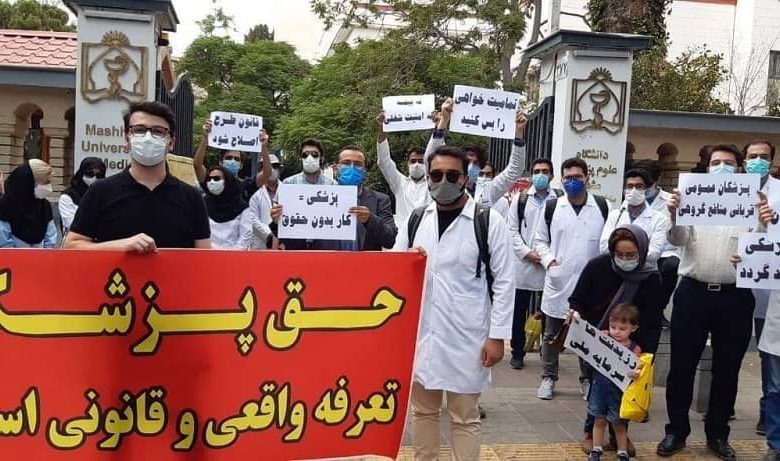Lack Of Job Security Forces Iran’s Medical Professional Into Suicide, Migration

iran-doctors-college-students-june2021 (1)
Written by
Mansoureh Galestan
The policies of the ruling clerics in Iran have had a devastating impact on the middle class over recent years, causing it to dwindle significantly, while poverty has expanded across the entire society. What was once considered as an issue affecting only unskilled workers and suburban residents of metropolises, has now spread to include even physicians, who are struggling under the weight of economic hardship. Reports from state-controlled media outlets provide a glimpse into this distressing reality.
On August 1, the state-run ILNA news agency reported the suicide of a medical resident, highlighting a troubling trend of 13 suicide cases among residents in one year. The report emphasized that residents, often earning meager wages without insurance coverage, are compelled to undertake grueling work with little hope for a better future.
Just two days later, other state-run outlets revealed the suicides of two nurses in a single day in Kermanshah. Poverty and work-related pressures were cited as the factors contributing to this tragic event.
Migration of Physicians
In a report published on August 10, the Shargh daily disclosed the migration of “16,000 physicians from the country” in the past three years alone. The state-run newspaper acknowledged, “According to experts, concerns about the educational and occupational future of their children, heavy economic pressures, income limitations, societal issues, and cultural challenges alongside demanding work environments in medical centers and universities are among the most significant reasons for the departure of healthcare professionals.”
Implicitly, “Shargh” conceded that the crisis was merely due to neglecting the livelihood and employment of physicians, stating, “If a physician isn’t recognized economically, financially, and socially, will they have any motivation to serve?”
On July 19, the news website Sahebkhabar reported that in recent years, 16,000 physicians have left Iran while another 4,027 physicians are currently prepared for migration.
Physicians under the poverty line
Furthermore, even state officials, despite attempting to manipulate and downplay the numbers, are forced to acknowledge a portion of the bitter reality. On August 23, 2021, Mohammad Bagher Heydari, the head of the Medical Council in Kermanshah Province, acknowledged that “70% of physicians are below the poverty line.”
Speaking to the government-affiliated ISNA news agency, he stated, “These low incomes have led to many general practitioners lacking the motivation to continue practicing medicine, and this issue is even observed in certain specialized fields.”
One year later, on May 24, 2022, Javan newspaper admitted to the meager income of physicians. The state-affiliated newspaper quoted a physician, stating, “A fee of 25,000 tomans for a general practitioner is not reasonable given the rising inflation. In the best-case scenario, only 12,500 tomans of that fee actually go to the physician. And if we consider ten million tomans as the threshold for the official poverty line of a monthly income, all general practitioners are below the poverty line.
Deputy Health Minister Acknowledges #Iran’s Doctor Shortage
Iran is suffering from a "serious shortage of physicians”, according to the Deputy Health Minister, as thousands of local doctors have emigrated.https://t.co/RZHyLcW9pQ pic.twitter.com/ojyVeFdX7h— NCRI-FAC (@iran_policy) July 1, 2019
On one hand, the clerical regime pays insignificant wages to physicians and exploits them, while on the other hand, as reported by Javan newspaper, it denies them inadequate government subsidies under the pretext that they are doctors and belong to the upper classes of society.
Javan wrote, “Grappling with financial challenges, general practitioners sometimes are compelled to migrate to Oman and Turkey in search of better incomes. In Oman, physicians are attracted to substantial earnings without requiring specific credentials or specialized exams. Many are willing to leave their homeland and families behind.”
Deviation from profession
However, this problem also manifests in a distinct manner, highlighting a significant societal crisis—corruption. This unfortunate reality further exacerbates the challenges faced by the public. Many patients are already grappling with livelihood difficulties, and the burden of healthcare expenses is pushing numerous families to the brink of bankruptcy or coming at the cost of breaking family bonds.
On July 4th, the Fars News Agency reported, “Under-the-table” dealings, a not-so-uncommon phenomenon in Iran, have become increasingly prevalent among physicians. In this practice, doctors receive from patients amounts other than the approved rates by the Ministry of Health, using various excuses and pretexts. These activities are carried out using excuses like “the card reader is malfunctioning,” “we lack a card reader,” or “please transfer the payment to this designated account number.”
According to this media outlet affiliated with the Revolutionary Guards, the names of over 1,786 non-compliant physicians have been sent to the Medical Council so far.
On July 30, the Saat24 website reported that the majority of state-run hospitals have been deprived of having specialized medical practitioners as physicians have either migrated or switched to other professions that offer better income prospects to cope with their living expenses.
This situation is present in a segment of society that, relatively speaking, holds a better position compared to other strata. However, the widespread poverty among Iranian physicians, leading to extensive migration and even tragic outcomes like suicides, demonstrates that no one in Iran is immune from the pervasive economic exploitation carried out by the ruling regime. This applies to all social classes and professions, highlighting that the grip of the theocratic regime’s exploitative practices spares no one.
Today, across Tehran, from students to Bazaar merchants & doctors; people have shaken the pillars of Khamenei’s rule with chants of “Death to the dictator”
The era of the criminal mullahs has come to an end; they cannot evade their inevitable overthrow#IranRevolution#MahsaAmini pic.twitter.com/Q2tTbF9vSQ— Maryam Rajavi (@Maryam_Rajavi) October 26, 2022

